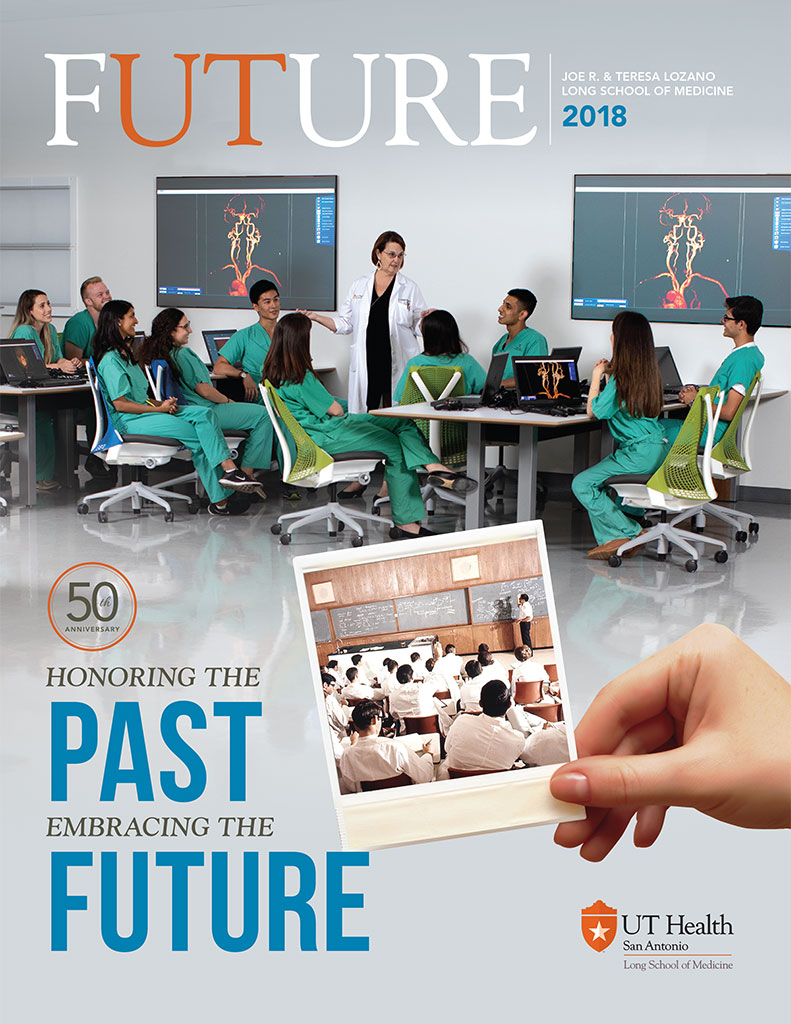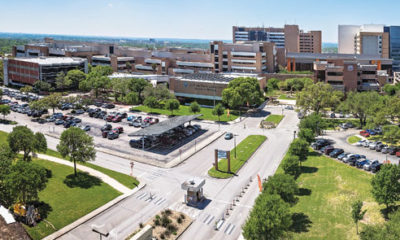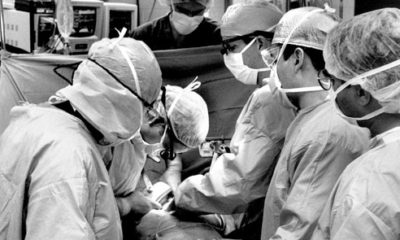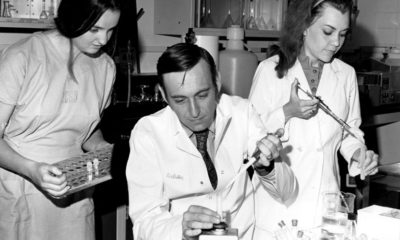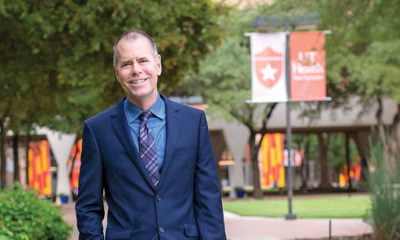50 Years of Academics: Main Mission Stays the Same
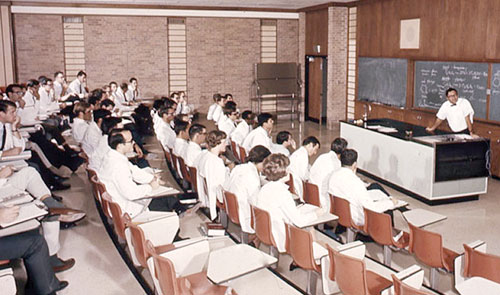
Creating Excellent Physicians Remains Constant Amid Changes
By Catherine Duncan
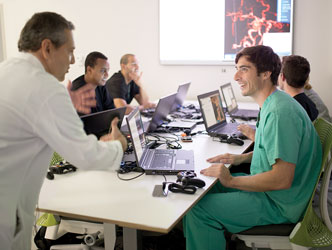
On Sept. 3, 1968, the doors to The University of Texas Medical School at San Antonio opened to 56 first-year students, 16 second-year students, and 33 third-year students.
The second- and third-year students had begun their classes at UT Southwestern Medical School in Dallas, the UT Medical Branch in Galveston or had transferred to San Antonio from outside the UT System.
These 105 students pursued their dream of attaining medical degrees in the freshly painted, unblemished hallways of the 440,000-square-foot medical school. The new facility featured teaching laboratories, a library, an auditorium, a laboratory animal resources area, offices and student activity areas.
However, prior to their arrival on that historic day 50 years ago, the founding leaders and faculty began working in 1962 to create what would become the initial curriculum for the fledgling school. They first worked in offices downtown.
Carlos Pestana, M.D., Ph.D., a founding faculty member in the Department of Surgery, recalls arriving on campus in January 1968. He had been recruited by J. Bradley Aust, M.D., Ph.D., founding chairman of surgery, who Dr. Pestana had met while he was doing a surgical residency at the Mayo Clinic and simultaneously working on his Ph.D. from the University of Minnesota.
“We all came from an academic background. We had been teaching at universities around the country,” said Dr. Pestana. “We were the new kids on the block. We wanted to teach them everything they would need to be outstanding physicians.”
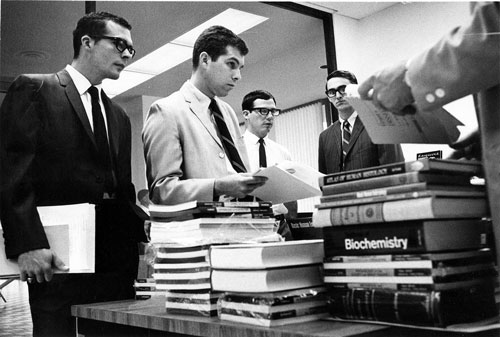
Establishing high standards
When the school opened, it was No. 4 in the country for the most hours students were required to be in the classroom, he explained. “The students didn’t really prefer that.” And in their zeal, the leaders decided to require seven clinical rotations of eight weeks each. “We forgot the year only has 52 weeks! Here we are requiring 56 weeks of rotations. We learned and adjusted.
“One thing that hasn’t changed is the quality of our students,” he explained. “They are the cream of the crop. They are highly motivated. It is not easy to get through medical school. It is extremely demanding and difficult,” Dr. Pestana said. “I’m so proud that we have been able to prepare exceptional physicians for the past 50 years.”

David Fuller, M.D., founding faculty member in psychiatry, arrived in the summer of 1968. He had previously been on the faculty at UT Southwestern for eight years. When the students began classes, he was struck by their tremendous enthusiasm.
“Everyone was so gung ho about starting at a new school,” he said. “How would I describe it? Pleasurable. Enriching. Growth oriented. Academic oriented.”
Because the school was new and small, there was a lot of interdepartmental work, he said. “The faculty all helped each other. We had schoolwide committees on curriculum review, research development and promotion. It was great because the faculty from different departments all got to know each other.”
Dr. Fuller said the initial curriculum was considered non-traditional at the time. “The traditional way was that each department ran their own courses separately. Each department traditionally did their own course or courses separate from everyone else.
“We decided to do a non-traditional model after a Canadian medical school. The teaching was by system—pulmonary, gastro-intestinal, neurological and so on,” he said. “What the students learned the first year was what is normal. The second year was what was pathological or what was wrong,” he said.
Students learned from many faculty members from different specialties, Dr. Fuller said. “The net effect was the departments had to work together to teach the students. In the process, we got to know each other and learned from each other.
“We did a collaborative curriculum that we were proud of, and the students responded to it with enthusiasm,” he said. “Since then, the curriculum has changed many times. People are constantly trying to make it better.”
Fred G. Corley, M.D., who came to UT Health in 1974 for his residency in orthopaedics, returned after two fellowships to teach, specializing in resident education, upper extremity fractures and patient care.
Dr. Corley said he joined as the fifth faculty member in the Department of Orthopaedics. Charles A. Rockwood, Jr., M.D., founding chair and professor and chairman emeritus, was fairly persuasive in getting him to return to San Antonio and teach medical students and residents, he added.
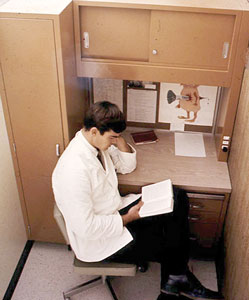
“The medical student curriculum was easier to manage in the early days. We did a series of lectures on the musculoskeletal system,” he said. “We all enjoyed teaching them about orthopaedics.”
Dr. Corley said another significant change is the increase in the number of women in the medical school and in the residency program. “Our first female resident was in 1978 and graduated from the residency program in 1983. This year, three out of the six residents are women. And, there are more women in medical school now. They are great students,” he added. In 1970, the incoming medical class had 30 male and three female students; in 2018, the incoming class had 113 male and 93 female students.
Kevin Schindler, M.D., chair of the curriculum committee for the medical school, attended the Long School of Medicine from 2001 until his graduation in 2005. “When I was in school, there was already a change taking place. The curriculum was going from a very subject-based approach to a more integrated systems-based approach. That change has accelerated with the new curriculum,” he said.
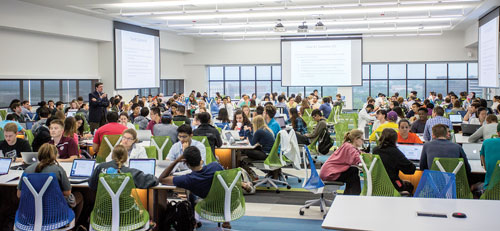
A change in curriculum
In 2010, planning began for the new curriculum called CIRCLE, an acronym for Curricular Integration: Researchers, Clinicians, Leaders, Educators. It was implemented in 2012, and the Class of 2016 was the first group to complete four years of CIRCLE.
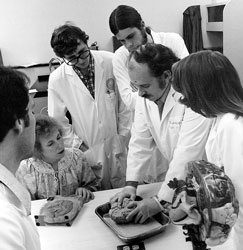
“The clinically important details of every subject are being taught from the very beginning of school,” said Dr. Schindler, who also works as a hospitalist at the Audie L. Murphy Memorial VA Hospital near campus. “The CIRCLE curriculum integrates basic science, clinical knowledge and the art of doctoring so students are learning crucial facts and how to practice medicine starting on the first day of school. It is all patient centered.”
The new curriculum relies on advanced technology, which has drastically changed the medical school experience, he said. “When I was in school, the bulk of learning was book based. We had online and digital sources to supplement our book learning. Now the primary resources are digital and online. I appreciate that these learning resources are easily accessible anywhere,” Dr. Schindler said.
“Students can pull out their laptops and study anywhere. I remember setting up in the Briscoe Library with five books in front of me. Now it is all on their laptops,” he said. “The newer generation of medical students is so technologically savvy.
“These students share in so many ways. They do Facebook groups and use texting applications like GroupMe. When I was in medical school, I felt isolated. You often studied by yourself. Students today are much better at collaborating with each other and helping each other out.”
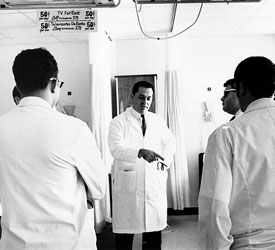
The technology also has changed the time spent in lecture halls listening to professors teach. “I remember being in the lecture hall seven or eight hours a day. I was lectured to during most of that time. Now, there is less lecture time and more time for self-study and working independently or in groups. I believe these students are developing skills to search for answers on their own instead of being told facts.
“My fellow medical students and I were good at rote memorization, but I don’t think we were as good at self-directed learning. I think this is important because medical knowledge is expanding so exponentially that just learning medical facts won’t serve you well going forward in your career. We are teaching them how to keep learning and digesting all that material. That is where medical education has gone over the last decade,” he said.
Another effect of new technology is the addition of the digital anatomy laboratory, which is located in the Academic Learning & Teaching Center. “We still have the gross anatomy lab with donated bodies, but the digital anatomy lab allows us to better understand very complex topics,” he said.
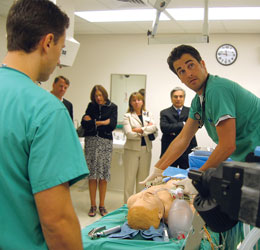
This digital software allows students to dissect real patients’ data, which includes CT scans and MRI images, he explained. Using a gaming controller, students can filter through different parts of the body so they can understand spatial relations in anatomy, he added.
Dr. Schindler said while he does expect the curriculum and technology to continue to change, he believes there will always be the emphasis on patient care first at the Long School of Medicine.
“That is why we all came to medical school—to learn to take care of patients. Our school has always produced excellent clinicians. We will continue to adapt the curriculum as needed, but the integrated, patient-centered, teamwork approach is here to stay. We will keep figuring out how to improve it,” he added.

